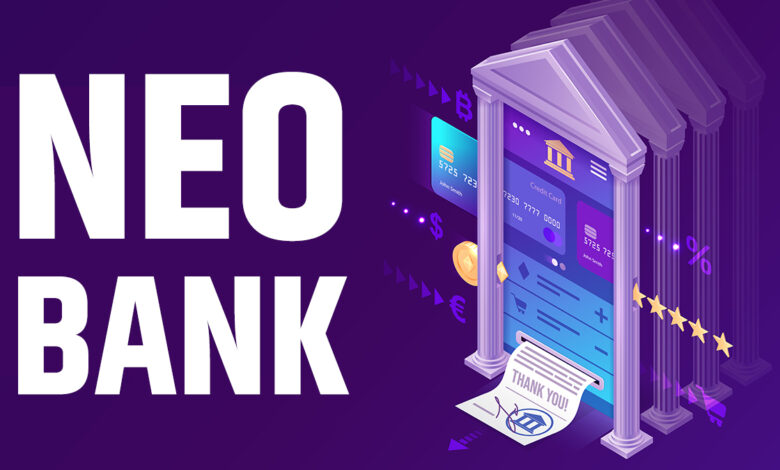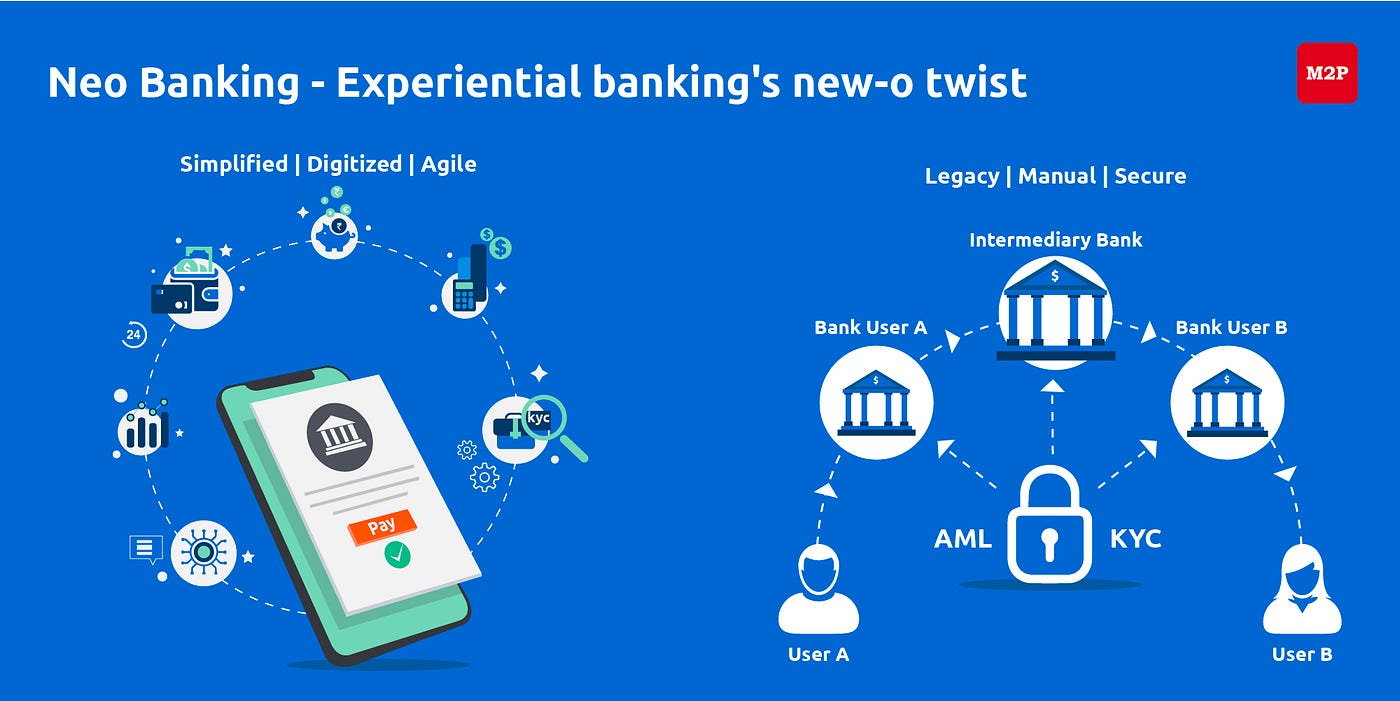How NeoBanks are changing the fate of India’s banking system

How NeoBanks are changing the fate of India’s banking system
Banks are undergoing rapid changes. Banks are changing their behaviour in terms of customer convenience, transparency, pricing, and customer service due to the increased use of disruptive technologies. Businesses and operational models have to change as customers’ behaviours and expectations change.
Using its technological prowess and agile and lean business models, a non-banking service provider now has access to every aspect of the banking value chain, from what consumers expect in terms of banking services. Rather than physical branches, these models provide retail and small and medium business banking services primarily through the internet or other electronic channels.
These non-banking providers are referred to as neobanks. They offer services and experiences that are more customer-centric and lower-cost compared to the current status of traditional banks. Traditional banks are constrained by legacy systems, tightly integrated value chains, complex administrative structures and stringent regulations, whereas neobanks aren’t. The neobanks in India don’t have their banking licenses, but they partner with bank-licensed service providers.
Micro and small companies and unbanked or underbanked customers such as freelancers and gig economy employees appreciate the convenience of opening and operating accounts, seamless payments, and transfer and remittance solutions. Neobanks have made financial services and products available to these segments, otherwise scarce or with high fees.
What are NeoBank?

Customers can obtain financial services at a lower cost through neobanks. With their assistance, customers can experience the convenience of traditional banks without the hassle of physical branches. Offering personalized services to customers while reducing operating costs is achieved by leveraging technology and artificial intelligence.
Banks license their services, but they do not possess a bank licence of their own. Due to RBI policy, banks aren’t allowed to be completely digital yet (although some foreign banks offer digital-only products through their local units.) The RBI remains staunchly committed to prioritizing banks’ physical presence and does speak out regarding digital banks’ physical presence.
Digital banks vs Neobanks
While they seem to be based on a mobile-first approach and emphasize digital operating models, a digital bank and a neobank aren’t the same. A digital bank is often the online-only subsidiary of an established, regulated player in the banking sector. In contrast, a neobank is an independent or partnered entity with no physical branches, and they can therefore comply with regulations and navigate the regulatory environment.
Neobanks vs traditional banks
Neobanks cannot compete with traditional banks on funding and — most importantly — customer trust. In addition, legacy systems weigh them down, and they struggle to adapt to a new generation with tech-savvy demands.
However, neobanks possess a unique weapon in their arsenal — innovation — that they cannot apply to traditional banks. Traditional banks are slow in launching new features and developing partnerships to serve their customers.
In general, traditional banks are less inclined to serve small businesses and retail customers who use neobanks. With innovative products and excellent customer service, they differentiate themselves through the mobile-first model.
Neobanks have advantages over traditional banks for MSMEs

- Customer Service: Neobanks do not offer innovative banking services to their customers, and traditional banks offer similar services; however, they provide a highly enhanced and personalized experience for customers. Comparatively to conventional banks, neobanks offer significantly leaner business models and superior technologies, including seamless account opening, 24/7 customer service via chatbots, near real-time cross-border payments, and automated accounting, budgeting, and treasury services powered by artificial intelligence (AI) and machine learning (ML).
- Mechanical services: The neobanks offer pre-and post-financial institution services on mobile platforms, including GST-compliant invoicing, tax payments record keeping, and reconciliation, as well as primary banking services.
- Transparency: Neobanks strive to be transparent and to notify their customers in real-time about any charges or fees they owe.
- Easy-to-use APIs: The APIs provided by neobanks allow the integration of banking into accounting and payment systems.
- Deep insights: Most neobanks offer dashboard solutions for managing payments, payables and receivables, and bank statements that provide excellent insight for users. Providing businesses with substantial expenditures and an appropriate number of employees with such insights reduces expenses and increase revenue and productivity.
Neobanks in India: Regulatory considerations

However, foreign national banks using their Indian subsidiaries to offer digital-only products can still get licences for virtual banking in India. RBI continues to emphasize the importance of the physical presence of banks and recently reiterated its requirement of some physical companies for providers of digital banking services.
Bank branches serve the purpose of providing customer service and redressing disputes and grievances in person. Payment banks are unlikely to become ‘virtual’ or branchless banks, according to the RBI’s 2014 Guidelines for Licensing of Payments Banks.
India’s neobanks are currently dealing with the regulatory dilemma by outsourcing their banking activities to licenced banks and creating strategic partnerships with traditional banks. Some of the biggest names in neobanking are already using this model.
Neobanks partner with traditional banks and offer business and consumer banking services as part of their business strategy to overcome regulatory barriers. From an end-user perspective, Neobank provides financial and banking services, but from a monetary perspective, their partner banks handle monetary transactions.
Top neobanks in India

- RazorpayX
Launched: November 2018
Automates manual, repetitive financial tasks and provides insight into money flow primarily for business owners and online merchants. Provides ledger support for current accounts simplifies payouts and offers credit solutions.
- Niyo
Launched: 2015
Provides zero-balance accounts with free accidental death insurance and salary advances to its customers. Users can also track, manage, and claim employee benefits using forex cards and tax-saving cards.
- Open
Launched: 2017
In addition to offering deposit accounts, money transfers, debit cards for online and offline purchases and expense management, Open is a neo bank for businesses and startups.
- EpiFi
Launched: 2019
The company offers individuals online banking services such as savings accounts, prepaid cards, bill payments, and money transfers. The company also provides insight into money management and interest-bearing savings accounts.
Neobanks face challenges
Neobanking market size is expected to reach $333.4 billion by 2026, growing at 47.1% CAGR. Neobanks, though, have their pros and cons, just like any other financial institution. They succeed in fulfilling the needs of a segment of the market and implementing a proper business strategy, work culture, and technology.
Even though they are all important, none of them is as important as building trust. Comparatively to traditional banks, neobanks are at a disadvantage in this case. Neobanking in India is thus supported by freemium models that give customers a chance to try the service before signing up.
Benefits of Neobanks
- Low costs: Because neobanks have fewer regulations and are not exposed to credit risk, their prices are low. Most products are inexpensive, and maintenance is not charged.
- Convenience: Many banks offer their customers banking services through an app (if not all).
- Speed: Neobanks offer fast account opening and request processing to their customers. Loan companies may use innovative strategies to evaluate your credit instead of the usual time-consuming application processes.
The drawbacks of Neobanks
- Regulatory Hurdles: Due to the RBI’s failure to recognize neobanks as such, customers are likely to have no legal recourse or defined process if they have a problem with a neobank.
- Impersonal: As neobanks do not have physical branches, customers do not have access to personalized service.
- Limited services: Neobanks typically don’t offer as many services as traditional banks do.
Case Study
SMEs in India can take advantage of a neobank’s services and solutions, helping them manage their finances quickly and comprehensively. Small businesses can use Neobank to send and receive payments, automate accounting and reconciliation, generate and verify tax compliance for invoices, and connect with third-party banking and business applications. The application also allows businesses to manage multiple accounts from one place.




